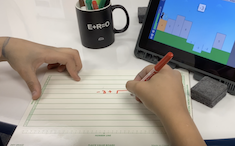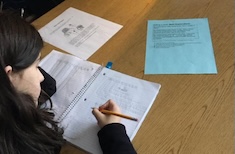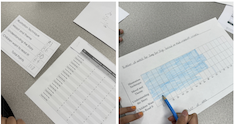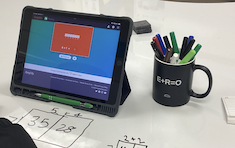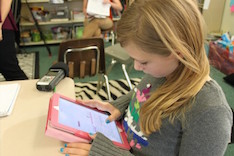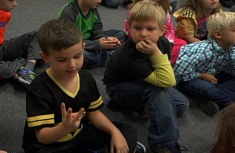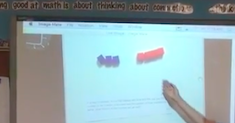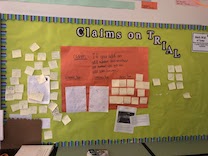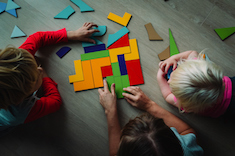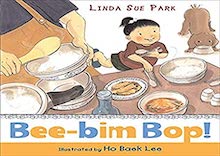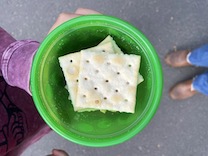Choice Numeracy
Latest Content
Leveling Up The Locker Problem
Finding a task as rich as The Locker Problem is a bit like finding the perfect read aloud. Jodie Bailey guides us to recognize different ways to turn a seemingly mundane problem into a rich task.
The Locker Problem: Choosing Tasks and Posing Questions That Elicit Core Mathematical Ideas
Mallory Messenger encourages us to broaden our thoughts about math tasks: It’s not about using that one task; it’s about choosing a task that will conjure up the mathematical ideas and thinking we want our students grappling with. Mallory shows how to be purposeful in the questions and tasks we ask students to complete, and offers an array of thinking stems to adjust to the wide range of needs in a classroom.
Setting Personal Goals for Math Independent Work
Mallory Messenger delivers a step-by-step guide to setting personal goals in math. Inspired by the practice of setting independent reading goals, Mallory explored the benefits of personal math goals. Download the Student Math Goals Self-Assessment and Reflection.
A Literacy Project Needed Math
Mandy Robek shares the way a Mock Caldecott project naturally connected to the math work happening in her third-grade class.
Developing Flexibility with Number Lines
Jodie Bailey offers clear and concise ways to use number lines as a tool to solve many different kinds of problems.
Vertical Conversations to Create Coherence
Jodie Bailey shows how representations and models help students understand complex math concepts. By participating in vertical conversations, teachers can strengthen our own understandings of skill progressions and help students develop essential connections and deeper understandings.
Delving Deeper Through Inquiry-Based Learning
Jodie Bailey suggests using books, pictures, or examples to begin or increase inquiry-based learning in your classroom. Using an example of learning more about pi from her classroom, Jodie offers ways to help students deepen their learning in any content area.
Purposeful Play
Jodie Bailey makes a case for purposeful play with her middle school students. To strengthen reading habits, we offer exposure to a wide variety of books, time to read, and opportunities to discuss ideas. In math classrooms, students need similar opportunities to explore and play.
Your Voice Matters
Jodie Bailey shares a picture-book version of Martin Luther King Jr.’s I Have a Dream speech and then gives students time to reflect on the message. While math class might seem like an unusual place to help students consider their identity and place in the world, Jodie inspires teachers to offer space and time for students to find their voice…while making direct connections to math standards.
Empowering Students Through Thinking Routines
Jodie Bailey shares practical ways to nourish students’ thinking routines in her math classroom. She is inspired by Peter Liljedahl’s book Building Thinking Classrooms.
Increasing Engagement During Online Practice Opportunities
Mallory Messenger is intentional about monitoring and supporting cognitive engagement while students use online practice tools. Use her tips so your students are engaged too!
Sparking Curiosity: Developing Ownership of Learning Through “What If” Questions
Jodie Bailey encourages us to use “What if” questions in all content areas to give students the space to use their innate curiosity to engage in meaningful learning.
Fostering Math Identities with Picture Books
Mandy Robek uses picture books to help her students build their identities as mathematicians. Mandy shares the process and a booklist.
From a Blank Canvas to a Community Space
Jodie Bailey approaches setting up her math classroom as a blank space with an invitation for students to engage in establishing identity, creativity, and collaboration.
Student-Generated Questions to Promote Problem Solving and Modeling with Mathematics
Mallory Messenger shares a process for students to engage and solve a type of intriguing question called Fermi Questions.
Choral Counting Routine
Mallory Messenger shares ways choral counting provides an opportunity for students to share ideas orally, process language and numbers, and bring out vocabulary within the context of looking for patterns.
Building Independence in Problem Solving
Mallory Messenger shares the intentional moves needed to help students build independence in problem solving.
Using Mathematics to Connect Home and School
Mandy Robek shares procedures for participation in Family Math. Family Math is a lens into the learning during the week and promotes math literacy at home.
Listening and Learning: Using Conferring to Better Understand What Students Are Thinking
Jodie Bailey shares the importance of conferring with students during math to reinforce what students are doing well and differentiate instruction.
Still Thinking: An Opportunity to Pause and Think Deeply
Jodie Bailey provides a structure to give students more time to think through ideas and problems. By using this practice, students gain ownership of their learning.
How Many? Counting Opportunities in Picture Books
Bitsy Parks shares the importance of counting and a booklist of picture books that lend themselves to counting opportunities.
Listening for Conjectures
Mallory Messenger shares a routine for hearing student conjectures (in math and other subjects) and a process for giving time for the class to prove or disprove the claims. Download a Conjecture—Prove or Disprove Recording Sheet to collect student conjectures in your classroom.
Feedback Through Conversations: An Asset-Based Approach
Jodie Bailey focuses on the importance of an asset-based lens when conferring with her students in math—and all content areas.
Routines That Normalize Mistakes
We all know that mistakes are part of learning and that safe environments for risk-taking allow students to grow, but how do you take the sting out of making mistakes? David Pittman offers advice on ways to normalize mistakes in math.
Math Debates: A Powerful Sense-Making Routine
Jodie Bailey shares a powerful practice of math debates for students to explore a problem with discussion and evidence to discover the correct solution.
Best Wrong Answer
Mallory Messenger shares a “best wrong answer” routine to help normalize mistakes while students think deeply about the math involved and help themselves look out for common mistakes to avoid.
Picture Books with Recipes to Foster Math Engagement
Mandy Robek shares a delicious list of picture books with recipes to connect reading and math engagement.
Math Is Everywhere
Bitsy Parks shares an initial read aloud to encourage primary students to develop the ability to see math everywhere.
First-Grade Math Lesson: Introduction and Partner Work
Danielle French’s first-grade students are practicing new math vocabulary during a lesson. This is the first video in a series.
First-Grade Math Lesson: Practice and Discussion
Students practice creating equations and using new vocabulary in the second installment of a math lesson from Danielle French’s first-grade classroom.
Browse Content By
Type
Category
- Assessment Tools
- Big Fresh Archives
- Booklists
- Choice Numeracy
- Classroom Design
- Common Core
- Community Building
- Conferring
- Content Literacy
- Digital Literacy
- English Language Learners
- Equity
- Family Relations
- Free Samples
- Guiding Groups
- Leadership
- Literacy Coaches
- Mentor Texts
- Minilessons
- New Teacher Mentors
- Podcasts
- Poetry
- Quote Collections
- Reading Strategies
- Self Care
- Struggling and Striving Learners
- Talking and Listening
- Teacher Study Groups
- Teaching Reading
- Teaching Writing
- Word Study and Vocabulary
Author
- Melissa Quimby
- Nawal Qarooni
- Gwen Blumberg
- Julie Cox
- The Lead Learners
- Hannah Tills
- Josie Stewart
- Ruth Metcalfe
- Mallory Messenger
- Becca Burk
- Jodie Bailey
- Vivian Chen
- Mary Brower
- Tiffany Abbott Fuller
- Stephanie Affinito
- Ruth Ayres
- Leigh Anne Eck
- Heather Fisher
- Shari Frost
- Julie Johnson
- Suzy Kaback
- Gigi McAllister
- Shirl McPhillips
- Melanie Meehan
- Cathy Mere
- Debbie Miller
- Tara Barnett and Kate Mills
- Tammy Mulligan
- Dana Murphy
- Bitsy Parks
- David Pittman
- Brenda Power
- Heather Rader
- Matt Renwick
- Mandy Robek
- Christy Rush-Levine
- Gretchen Schroeder
- Jen Schwanke
- Brian Sepe
- Katherine Sokolowski
- Stella Villalba
- Jennifer Vincent
Grade Level
Choice Literacy Membership
Articles
Get full access to all Choice Literacy article content
Videos
Get full access to all Choice Literacy video content
Courses
Access Choice Literacy course curriculum and training

